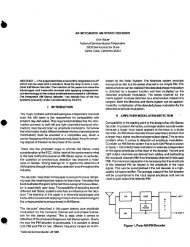- Page 1 and 2: PNG (Portable Network Graphics) Hom
- Page 3 and 4: PNG (Portable Network Graphics) Hom
- Page 5 and 6: PNG (Portable Network Graphics) Hom
- Page 7 and 8: Intro to PNG Features A Basic Intro
- Page 9: Intro to PNG Features application t
- Page 13 and 14: Intro to PNG Features PNG's 2D inte
- Page 15 and 16: Intro to PNG Features * Greg follow
- Page 17 and 18: PNG-supporting Applications ❍ Pal
- Page 19 and 20: PNG: Current Status Current Status
- Page 21 and 22: PNG: Current Status background, but
- Page 23 and 24: PNG: Current Status the Qt GUI tool
- Page 25 and 26: PNG Frequently Asked Questions Ther
- Page 27 and 28: PNG Frequently Asked Questions RGB
- Page 29 and 30: PNG Frequently Asked Questions A: N
- Page 31 and 32: History of PNG This article origina
- Page 33 and 34: History of PNG 15 Jan 97 PNG spec 1
- Page 35 and 36: History of PNG Current Status So wh
- Page 37 and 38: History of PNG patent information g
- Page 39 and 40: History of PNG Last modified 12 Jun
- Page 41 and 42: PNG News from 2006 ● 14 April 200
- Page 43 and 44: PNG Resources of the Miscellaneous
- Page 45 and 46: PNG Resources of the Miscellaneous
- Page 47 and 48: PNG Resources of the Miscellaneous
- Page 49 and 50: PNG Resources of the Miscellaneous
- Page 51 and 52: PNG Resources of the Miscellaneous
- Page 53 and 54: PNG Documentation libpng Documentat
- Page 55 and 56: PNG Documentation ● PNG: The Defi
- Page 57 and 58: PNG (Portable Network Graphics) Spe
- Page 59 and 60: zlib Documentation Specifications T
- Page 61 and 62:
zlib Documentation US (Virginia) US
- Page 63 and 64:
zlib Documentation IETF copy (UK) I
- Page 65 and 66:
MNG Documentation MNG Documentation
- Page 67 and 68:
MNG Documentation MNG-VLC specifica
- Page 69 and 70:
MNG Documentation France JPEG image
- Page 71 and 72:
PNG: The Definitive Guide ● Detai
- Page 73 and 74:
PNG: The Definitive Guide Here are
- Page 75 and 76:
PNG-supporting Browsers colors); pa
- Page 77 and 78:
PNG-supporting Browsers ● Communi
- Page 79 and 80:
PNG-supporting Browsers ● Interne
- Page 81 and 82:
PNG-supporting Browsers transparenc
- Page 83 and 84:
PNG-supporting Browsers which was s
- Page 85 and 86:
PNG-supporting Browsers of embedded
- Page 87 and 88:
PNG-supporting Browsers ❍ Image E
- Page 89 and 90:
PNG-supporting Image Viewers ● Ah
- Page 91 and 92:
PNG-supporting Image Viewers ● Di
- Page 93 and 94:
PNG-supporting Image Viewers Proces
- Page 95 and 96:
PNG-supporting Image Viewers imagin
- Page 97 and 98:
PNG-supporting Image Viewers applic
- Page 99 and 100:
PNG-supporting Image Viewers stills
- Page 101 and 102:
PNG-supporting Image Viewers ● Qu
- Page 104 and 105:
PNG-supporting Image Viewers ● Tu
- Page 106 and 107:
PNG-supporting Image Viewers ● xl
- Page 108 and 109:
PNG-supporting Image Editors Image
- Page 110 and 111:
PNG-supporting Image Editors conver
- Page 112 and 113:
PNG-supporting Image Editors with s
- Page 114 and 115:
PNG-supporting Image Editors ● iv
- Page 116 and 117:
PNG-supporting Image Editors (Title
- Page 118 and 119:
PNG-supporting Image Editors Mac, i
- Page 120 and 121:
PNG-supporting Image Editors ● Tu
- Page 122 and 123:
PNG-supporting Image Editors ❍ Im
- Page 124 and 125:
PNG-supporting Image-Conversion App
- Page 126 and 127:
PNG-supporting Image-Conversion App
- Page 128 and 129:
PNG-supporting Image-Conversion App
- Page 130 and 131:
PNG-supporting Image-Conversion App
- Page 132 and 133:
PNG-supporting Image-Conversion App
- Page 134 and 135:
PNG-supporting Image-Conversion App
- Page 136 and 137:
PNG-supporting Image-Conversion App
- Page 138 and 139:
PNG-supporting Image-Conversion App
- Page 140 and 141:
PNG-supporting Image-Conversion App
- Page 142 and 143:
PNG-supporting Image-Conversion App
- Page 144 and 145:
PNG-supporting Image-Conversion App
- Page 146 and 147:
PNG-supporting 3D Applications 3D A
- Page 148 and 149:
PNG-supporting 3D Applications Cosm
- Page 150 and 151:
PNG-supporting 3D Applications ●
- Page 152 and 153:
PNG-supporting 3D Applications (GPL
- Page 154 and 155:
PNG-supporting 3D Applications ●
- Page 156 and 157:
PNG Support in VRML Browsers opaque
- Page 158 and 159:
PNG Support in VRML Browsers Win32
- Page 160 and 161:
PNG Support in VRML Browsers Win32
- Page 162 and 163:
PNG Support in VRML Browsers Linux
- Page 164 and 165:
PNG-supporting Games and Entertainm
- Page 166 and 167:
PNG-supporting Games and Entertainm
- Page 168 and 169:
PNG-supporting Games and Entertainm
- Page 170 and 171:
PNG-supporting Games and Entertainm
- Page 172 and 173:
PNG-supporting Office and Business
- Page 174 and 175:
PNG-supporting Office and Business
- Page 176 and 177:
PNG-supporting Office and Business
- Page 178 and 179:
PNG-supporting Scientific and Graph
- Page 180 and 181:
PNG-supporting Scientific and Graph
- Page 182 and 183:
PNG-supporting Scientific and Graph
- Page 184 and 185:
PNG-supporting Scientific and Graph
- Page 186 and 187:
PNG-supporting Miscellaneous Applic
- Page 188 and 189:
PNG-supporting Miscellaneous Applic
- Page 190 and 191:
PNG-supporting Miscellaneous Applic
- Page 192 and 193:
PNG-supporting Miscellaneous Applic
- Page 194 and 195:
PNG-supporting Miscellaneous Applic
- Page 196 and 197:
PNG-supporting Miscellaneous Applic
- Page 198 and 199:
PNG-supporting Miscellaneous Applic
- Page 200 and 201:
PNG-supporting Hardware Hardware wi
- Page 202 and 203:
PNG-supporting Hardware various off
- Page 204 and 205:
PNG-supporting Libraries and Toolki
- Page 206 and 207:
PNG-supporting Libraries and Toolki
- Page 208 and 209:
PNG-supporting Libraries and Toolki
- Page 210 and 211:
PNG-supporting Libraries and Toolki
- Page 212 and 213:
PNG-supporting Libraries and Toolki
- Page 214 and 215:
PNG-supporting Libraries and Toolki
- Page 216 and 217:
PNG-supporting Libraries and Toolki
- Page 218 and 219:
PNG-supporting Libraries and Toolki
- Page 220 and 221:
PNG-supporting Libraries and Toolki
- Page 222 and 223:
PNG-supporting Libraries and Toolki
- Page 224 and 225:
PNG-supporting Libraries and Toolki
- Page 226 and 227:
libpng Home Page Mailing list: Sour
- Page 228 and 229:
libpng Home Page Finally--and most
- Page 230 and 231:
zlib Home Site ● Fix crc check bu
- Page 232 and 233:
zlib Home Site zlib source code, ve
- Page 234 and 235:
zlib Home Site (includes compiled o
- Page 236 and 237:
PNG Source Code PNG Source Code For
- Page 238 and 239:
PNG Source Code ● PNG DataType (#
- Page 240 and 241:
PNG Source Code ● RO-Viewer (Win3
- Page 242 and 243:
PNG Source Code ● PNG Pooper (BeO
- Page 244 and 245:
PNG Source Code ● Stereograph (Li
- Page 246 and 247:
PNG Source Code ● FBShot (Linux/f
- Page 248 and 249:
PNG Source Code ● Xenomorph (Unix
- Page 250 and 251:
PNG Suite Test Icons Chromaticity-c
- Page 252 and 253:
PNG Suite Test Icons basn2c16 - 3x1
- Page 254 and 255:
PNG Suite Test Icons tbrn2c08 - tra
- Page 256 and 257:
PNG Suite Test Icons 3.10 Chunk ord
- Page 258 and 259:
PNG VRML Textures in 2D PNG VRML Te
- Page 260 and 261:
PNG VRML Textures in 2D 3x3 squares
- Page 262 and 263:
PNG Interlacing Demo How PNG's Two-
- Page 264 and 265:
PNG Interlacing Demo 320x240 PNG im
- Page 266 and 267:
PNG Interlacing Demo ● PNG suppor
- Page 268 and 269:
Miscellaneous PNG Images using IMG
- Page 270 and 271:
Miscellaneous PNG Images using IMG
- Page 272 and 273:
Miscellaneous PNG Images using OBJE
- Page 274 and 275:
Miscellaneous PNG Images using OBJE
- Page 276 and 277:
Miscellaneous PNG Images using OBJE
- Page 278 and 279:
32-bit RGBA PNGs on yellow stucco [
- Page 280 and 281:
32-bit RGBA PNGs on yellow stucco H






